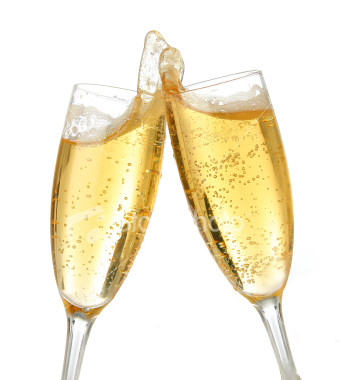| FOOD FOR THOUGHT |
ELV note: We recorded this at KNPR in December, 2004, and you can listen to us perform the script in the mellifluous, whimsical and melancholy tones for which we were known by clicking on the link below. Happy New Year 2012!

You’re Toast!
Archived audio Real Audio |
Happy New Year, Great Saturnalia, Season’s Greetings or Yumpin’ Yule– however you celebrate the shortest days of the year, I’m sure food (and especially drink), has a lot to do with it. And since all holiday celebrations begin or end with a toast, I thought some information about how all that clinking of glasses came about, might be fun, and provide some good conversation fodder should you find yourself trapped behind a punchbowl with nothing witty to say.
Toasting came about because once upon a time the rich and famous were in the nasty habit of poisoning each other rather than filing lawsuits. A nobleman in 14th century Europe in the midst of a pesky property dispute with his neighbor might suggest mead cocktails at Lancelot Lagasses or the Earl of Puck’s Steakhouse so they could “settle” things. Rather than appear with a high priced mouthpiece to plead his case, or perhaps lacking any real evidence that he was entitled to starve his serfs into submission and steal their land, His Royal Fullness would have his in-house chemist poison the wine or beer (usually the only disease-free potable liquid), of his political or business opponents. One dinner, a few drinks and poof, no more plaintiff! When you consider the time and money saved in court costs, legal fees, and copying charges, it was a beautiful system. Unfortunately it made dining with strangers, and especially your relatives, a dicey proposition.
So the expense-account crowd in medieval London, came up with a custom to take the stress out of imbibing anywhere but your own back yard. The host would take some toast (dry bread soaking up more liquid than fresh), and dip it into his guests flagons and take a bite. Assuming he didn’t keel over, everyone breathed a sigh of relief, got drunk, and went back to the business of debauchery and exploiting peasants.
The glass clinking thing dispensed with the bread, and had the host pour some of his guest’s wine into his glass or cup, and then drank up. Upon seeing him do this, everyone clinked (or clunked) their wooden or metal cups together, signifying trust and honesty at the table. So along with this indispensable trivia, here’s a six-pack of pretentiously obscure toasts to use instead of the same old boring “cheers!” or “salud!” over this year’s vintage bottle of October 2004 Manischewitz. All of these are some version of “to your health” or “here’s to good food and drink”:
In Basque it’s Topa. Greeks say Kali Orixi. While Russians yell Na’zdroveya. Asturians (whoever they are) proclaim Gayola, and in Italian you say Chin Chin. (which is not to be made amongst Japanese, since you would be toasting their penises)
And my personal favorite: In Zulu – Oogy Wawa. This is John Curtas wishing you a Happy New Year Topa! Chin Chin! Oogy Wawa! and Gayola!!
Really, all that even a nod to Manischewitz as discussing as it is and no L’chaim?